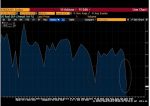US rates and the dollar hardly responded to the disappointing jobs report. The 194k rise in the nonfarm payrolls was the least this year, but of course, it is subject to revisions the way the August series was revised by more than 50% to 366k. One critical problem was that hiring by local governments for the start of the school season was less than usual, and with the seasonal adjustment, it turned into a decline. On the other hand, the private sector added 317k, the third consecutive month of more than 300k after the August series was revised to 332k from 243k. The household survey reported a 526k increase in jobs, and even if one adjusts for some definitional confusion, around 480k, it is still more than twice the establishment survey estimate. Average hourly
Topics:
Marc Chandler considers the following as important: 4) FX Trends, 4.) Marc to Market, Featured, newsletter, USD
This could be interesting, too:
RIA Team writes The Importance of Emergency Funds in Retirement Planning
Nachrichten Ticker - www.finanzen.ch writes Gesetzesvorschlag in Arizona: Wird Bitcoin bald zur Staatsreserve?
Nachrichten Ticker - www.finanzen.ch writes So bewegen sich Bitcoin & Co. heute
Nachrichten Ticker - www.finanzen.ch writes Aktueller Marktbericht zu Bitcoin & Co.
US rates and the dollar hardly responded to the disappointing jobs report. The 194k rise in the nonfarm payrolls was the least this year, but of course, it is subject to revisions the way the August series was revised by more than 50% to 366k.
One critical problem was that hiring by local governments for the start of the school season was less than usual, and with the seasonal adjustment, it turned into a decline. On the other hand, the private sector added 317k, the third consecutive month of more than 300k after the August series was revised to 332k from 243k. The household survey reported a 526k increase in jobs, and even if one adjusts for some definitional confusion, around 480k, it is still more than twice the establishment survey estimate. Average hourly earnings rose by 0.6%, though the August increase was revised to 0.4% from 0.6%.
Not only were there more workers that were getting paid a little more, but they also worked more. In August, the average workweek increased to 34.8 hours from a downwardly revised 34.6 hours (from 34.7). Unfortunately, the most disappointing element of the report took some of the shine from the best part of the report. The unemployment rate fell to 4.8% from 5.2%, much larger than expected, but some of the decline stemmed from the reduced participation rate, which slipped to 61.6% from 61.7%.
The market could look past the employment data because there is little doubt that the report was sufficiently strong to allow the Federal Reserve to go forward with plans to reduce its bond purchases starting next month. The incremental contribution to the information was minor. In fact, the December 2022 Fed Funds futures contract implied a slightly greater chance of two hikes next year after the report. The dollar softened a little response to the jobs report. With the help of an unambiguously strong jobs report, the Canadian dollar extended its recovery to two-month highs and leading the majors last week with a nearly 1.5% gain. With the US 10-year yield probing its best level since June, it is little wonder that the yen was the weakest of the major currencies, with the greenback rising to new highs for the year.
Dollar Index: The Dollar Index peaked on September 30 near 94.50. After backing off to nearly 93.65 at the start of the week, it bounced back to test the previous high. It held. A consolidative or corrective phase has begun. What can morph the former into the latter would be a break of 93.65, which would mark the double top and project toward 92.80, which is a little below the (61.8%) retracement target of last month's rally. Alternatively, a triangle or flag pattern could be unfolding, often thought of as continuation patterns. The MACD and Slow Stochastic appear to be rolling over.
Euro: Selling pressure pushed the euro to a new low for the year in the middle of last week, near $1.1530. It remained within Wednesday's range (~$1.1530-$1.1605) for the following two sessions. In fact, it was unable to resurface above $1.1600, even after the weakest US jobs growth this year. Nevertheless, the momentum indicators are that the late shorts may be vulnerable. The MACD looks poised to turn higher, while the Slow Stochastic is maybe turning higher. A move above $1.1600 would help, but the $1.1640 area must be overcome to signify anything more than consolidation. On the downside, the next important area is around $1.15, which also holds the (50%) retracement of the rally since the March 2020 low is closer to $1.1490.
Japanese Yen: The rise in US yields after the employment report helped lift the dollar almost JPY112.25, matching last year's high. The 2019 high was near JPY112.40. Often it seems that when the yen appears to be trending, it is moving to a different trading range. If the last range was JPY109-JPY111, the new one might be JPY111-JPY113. In 2017 and 2018, it looked as if the range was JPY105-JPY115. The MACD is headed higher, and Slow Stochastic pulled back in from overbought territory and is turning higher again. Unlike in late September, when the dollar was testing JPY112 and was outside the Bollinger Bands, this time, the upper Bollinger Band is higher near JPY112.45.
British Pound: Sterling rose in four of last week's five sessions to snap a four-week slide. After spending the week in choppy activity between around $1.3550 and $1.3650, it made a marginal new high before the weekend. We suspect sterling is correcting the drop from the second half of September that took it from almost $1.3915 to nearly $1.3410. The halfway mark is about $1.3665, a little above the 20-day moving average (~$1.3655). The next retracement target (61.8%) is near $1.3720. The momentum indicators have recently turned up and are trending higher. The implied yield of the March 2022 short-sterling interest rate futures contract jumped 7 bp before the weekend, nearly half of the week's gain and the fifth consecutive weekly increase. It has risen by about 35 bp over this span.
Canadian Dollar: A unexpectedly strong employment report helped lift the Canadian dollar ahead of the weekend. It was the 11th gain in the past 15 sessions. Canada grew nearly 194k full-time jobs. Given the relative size of the economies, it would be as if nonfarm payrolls jumped by 2 mln in the US. While the US participation rate is 1.3 percentage points lower than before the pandemic struck, Canada has fully recovered at 65.5% with the September report. We have suggested that the US dollar appears to have traced a head and shoulders topping pattern. The neckline is around CAD1.26, and the pattern projects to about CAD1.23. The caveat is that the move is getting stretched. The lower Bollinger Band will start the new week slightly below CAD1.2500. The MACD has been trending lower since the second half of July and is now at its level in more than three months. The Slow Stochastic is oversold, though it is still trending lower. This suggests there may be some limited scope for additional near-term US dollar losses, and a break of CAD1.2550 could see CAD1.25, which looks to be more important support. Lastly, with the Bank of Canada's rhetoric turning more hawkish, the implied yield of the June 2022 Banker Acceptances rose every day last week for the fifth consecutive weekly rise. It has increased by a cumulative of nearly 20 bp, and at 85 bp, it is the highest in three months.
Australian Dollar: Although the Australian dollar rose to new three-week highs before the week a little above $0.7335, the momentum faded, and it settled on a soft note in the lower half of the session's range. Still, it held on to a modest gain for the week, its first after four weeks of declines. The momentum indicators are still pointing higher. The week-and-a-half-long trendline comes in near $0.7265 to start the new week. A break signals a retest on the $0.7170-$0.7200 area. Australia reports its September jobs figures early in Canberra on October 14. Another sharp loss of jobs is expected after August's 146k drop. September may be the nadir as the virus and lockdowns crest. Meanwhile, the Australian dollar has continued to recover against the New Zealand dollar. Recall that it trended lower from mid-June through mid-September, falling nearly 5%. It has rebounded to test the halfway mark (~NZD1.0550). The next retracement (61.8%) is a little above NZD1.06. In September, the New Zealand dollar was the weakest of the majors, depreciating by slightly more than 2%. The market has unwound some of its aggressive hawkish positions.
Mexican Peso: The peso, like other emerging market currencies, remains out of favor. Consider that the JP Morgan Emerging Market Currency Index did not just fall every day last week, but it has dropped 12 of the past 15 sessions. The greenback reached six-month highs last week, slightly above MN20.8865. Above there, a band of resistance is seen between MXN20.90 and MXN21.00. The MACD is trending higher but stretched, while the Slow Stochastic slipped over-extended conditions but appears to be about to turn higher again. Recall that the dollar's high so far this year was set in March around MXN21.6360. With September CPI rising to 6.0%, Banxico has little choice but to hike rates again when it meets next month. The swaps market has a little more than 50 bp of tightening discounted over the next three months.
Chinese Yuan: The US dollar settled slightly below CNY6.4450 on the eve of the Golden Week holiday. Mainland markets re-opened for the first time before the weekend, and lo and behold, that exchange rare was steady, unimpacted by the myriad of developments. The dollar finished slightly below CNY6.4440, a change of about 0.02%. The NASDAQ Golden Dragon Index that tracks Chinese companies that trade in the US gained 3.8% while the mainland was on holiday and extended those gains by another 1% ahead of the weekend. The 10-year premium China pays to borrow above the US has fallen to about 130 bp, down nearly 100 bp since the start of the year, and the lowest in around 18 months. The dollar recorded a three-month low in September near CNY6.43. There may be conflicting influences, but on balance, we suspect Chinese officials are content with a broadly stable dollar-yuan exchange rate. Still, the PBOC also monitors the yuan against a trade-weighted basket. It appears willing to accept some appreciation against the CFETS but limited.
Tags: #USD,Featured,newsletter









